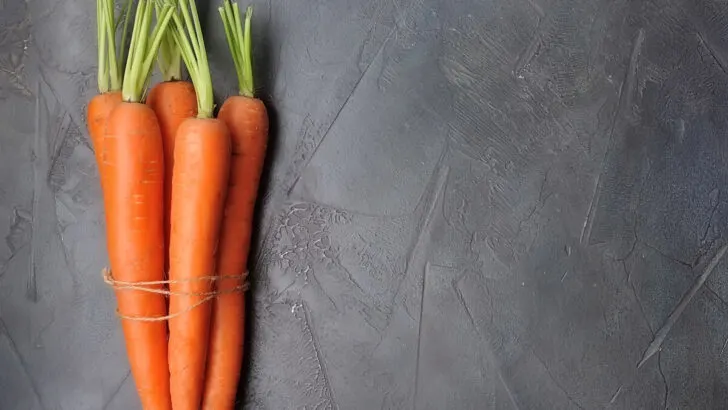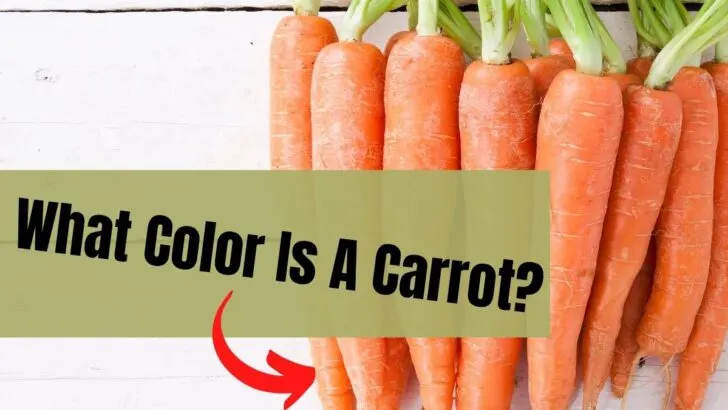We usually think that the carrots we all love to eat are always orange. However, that’s not entirely true. These crunchy vegetables once came in a kaleidoscope of shades, making one wonder what color a carrot is and why they come in varied hues.
The color of a carrot varies with the soil and nutrients they are grown in, which can cause carrots to come in vivid shades of orange, yellow, purple, red, and white. Carrots, depending on their color, will have varying levels of vitamins and antioxidants, which also has an impact on how they taste.
Read on to learn more about the colors of carrots and what these symbolize about the vegetable.
What Color Were Carrots Initially?
Carrots originally developed from a wild carrot species in Central Asia about 5,000 years ago. These were originally white due to Daucus carota, a pale white wild carrot.
All present-day carrots share this same ancestor.
Carrots started varying in color as they were grown in different parts of the world. For instance, purple carrots were first discovered by Middle Eastern farmers.
With time, yellow carrots were cultivated and introduced in the markets. When yellow carrots were brought to Europe in the 14th century, there they started to develop the characteristic orange tint.
Do Different Colors of Carrots Still Exist?
Although orange carrots have become the standard color for most people, other colors of carrots can still be found and grown. Specialized nurseries often focus on the fresh rainbow aspects of carrots so they can still be seen and enjoyed in different delicacies.
In general, carrots are quite simple to cultivate, and seeds from garden stores are currently available and ready to be sown in your garden.
What Colors Are Carrots Available In?
Nutrients in soil affect how bright or pale the color of carrots will be. Carrots grown in western parts of the world develop a white, yellow, or orange tone. However, the roots in Eastern areas give off a shade of red, purple, or even black.
One fascinating fact about purple carrots is that you might come across multi-colors on the inside. This novelty is a recent innovation and is a way to spruce up your dinner dish.
What Gives Carrots Their Various Colors?
There are many answers to why carrots are found in different colors. However, the most logical explanation is that the soil’s nutritional content influences its shades.

Like in orange carrots, due to their richness in beta carotene, it develops the classic orange hue.
Unlike red carrots which have an abundance of lycopene, the exact nutrient that gives tomatoes their red tint. Yellow carrots on the other hand contain high levels of “the eye vitamin,” scientifically known as lutein.
White carrots also contain beta carotene like orange ones, but due to their smaller levels, it is unable to develop the shade perfectly.
Further, the purple pigment in purple carrots is due to the high amount of the same nutrient found in eggplants, anthocyanins.
The higher the traces of anthocyanins are found the more pigmented they appear. When purple carrots develop excessive amounts of anthocyanins, they look to be black.
Interestingly, purple carrots with orange centers have both anthocyanins and beta carotene while ones with white centers have only a few traces of beta carotene along with anthocyanins.
This then explains to us that purple carrots with yellow centers contain anthocyanins and lutein.
Colorful carrots, along with being nourishing, also look appealing to the eyes. But just because they look nice on your plate, doesn’t always mean they will taste good. This then brings us to our last question.
Does the Color of Carrots Affect Their Taste?
Absolutely yes! Orange carrots are widely common as they are considered to have the most appetizing taste. They have the perfect amount of sweetness with a unique flavor that is not too overbearing. Additionally, the crispy and juicy texture is pleasant to add to your dishes to give them a good crunch.
Varying pigments of carrots do affect their taste. For instance, purple carrots taste almost like radishes due to their spicy and tangy flavor. They are also considerably sweeter than orange carrots.
White carrots have the pleasant, earthy qualities you’d anticipate from a root vegetable and taste almost like parsnips. White carrots make a wonderful substitute for orange carrots since they are noticeably crisp.
Moreover, red carrots are equally crisp and crunchy just that they feature a stronger carrot flavor. Due to it being rich in lycopene, they are a good source of antioxidants that reduce inflammation.
Lastly, the yellow carrots taste surprisingly depends on which stage you pick them up. Young and tender yellow carrots taste very sweet than orange and purple carrots. They have a sweet, fruity finish with a flavor that is comparable to sweet potatoes.
Final Words on the Color of Carrots
To sum it up, the color of a carrot depends on a variety of factors. In the past, multi-colored carrots were quite normal. However, nowadays, orange carrots are grown more due to their globally appreciated taste.
Moreover, carrots of red, yellow, purple and white colors are also grown and used all over the world due to their distinctive flavors.


